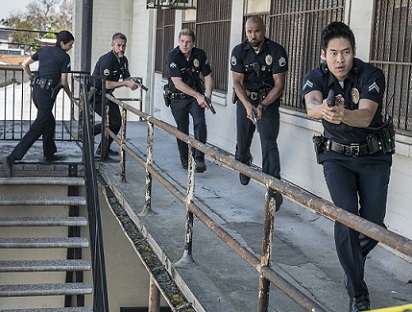| Features Features Archive  Email A Friend Email A Friend
May 4, 2025
Why do so many injury lawyer billboards dot our landscape? February 21, 2025
Carlsbad lifeguard, Alex Shaner, walking again after ocean accident June 28, 2024
Restaurant Industry Set to Confront Workers' Comp Challenge with New Food and Beverage Insurance Rating Classification August 9, 2021
The Property Claims Investigation

|  | Texas Executes Workers’ Compensation Claimant For Killing A Witness And His Son And Two Other Witnesses.
By Jorge Alexandria - October 24, 2017
Forget heart disease. Forget cancer. For any adjuster handling workers’ compensation claims, the greatest existential threat is from a deranged injured worker.
After 26 years on Texas’ death row, James Eugene Bigby became the 1,448th person executed in the United States since 1976, the 542nd person executed in Texas, and the 1,273rd person judicially executed by lethal injection. He was declared dead by the Texas Department of Justice on March 14, 2017 at 6:31 P.M. at the age of 61.
James Bigby, an injured worker, from the small north Texas town of Kennedale, was sentenced to death for the 1987 murder of a key witness against him in his workers’ compensation claim proceedings, Michael Trekell, and his infant son, Jayson Kehler. He was also accused, but not convicted, of shooting and killing two other friends/witnesses, Calvin Crane and Frank Johnson, that he believed had undermined his claim
Court documents show that in 1985 Bigby began working for the Frito Lay Company (now Pepsico/Frito Lay) as an auto mechanic who assisted in the maintenance of their delivery trucks. After a year on the job, he injured his back and filed a workers' compensation injury claim against them and their third party claims administrator (TPA), Sedgwick. As is standard operating procedure, then as now, his claim was delayed pending an employer level investigation. The claimant became convinced that Frito Lay and the TPA were conspiring against him to prevent any payment on his claim. He also believed that he had gathered enough data on the TPA to have the company suspended from operating in Texas, and as a result, the TPA was prepared to “take him out.” The number of “conspirators” grew slowly, eventually including some close friends and family members. The first sign of trouble emerged when Bigby rammed his car into the automobile of one of the insurance investigators who had been assigned to conduct video subrosa and follow him. Bigby was charged with criminal mischief and he pled guilty to that charge.

Soon red flags were evident to those that came in contact with Bigby. His father, a postal worker, would later testify that Bigby was paranoid and that Bigsby believed his apartment was “bugged”. His first workers’ compensation attorney withdrew from representation because Bigby became obsessed and desired an increased role in the investigation. His second attorney, Mr. Obeidin, also withdrew when Bigby informed him of his beliefs that certain Frito Lay people were following him, trying to poison him through the emission of a poisonous green gas though his air conditioning vent, and recording his conversations. Interestingly enough, in December 1987, just days prior to the commission of the murders, Bigby was admitted for severe depression to the psychiatric floor of Saint Joseph Hospital. He received electro shock therapy and was released. Later, the surviving spouse of the deceased, and the infant’s mother, Grace Kehler, would sue the hospital in civil court for negligent acts and improper treatment of Bigby that she alleged to be the proximate cause of the victims’ death.
On Christmas Eve, 1987, Bigby went to the home of the person he had come to suspect of conspiring against him and who had spoken to the AOE/COE investigator. This was his long-time friend and colleague, Michael Trekell, age 26, who was there caring for his 4-month-old infant son, Jayson. Claimant later stated to police, “I had been thinking about getting back at him for a while ... and it was on my mind when I came to his house that night. While Mike was fixing the steaks I went over to him, and the next thing I knew I shot him with a Ruger .357 Magnum, with 158 grain silver tips. When I shot Mike, he was sitting at the kitchen table. He never saw the gun and didn’t know I was going to shoot him.”
He then went to the infant’s room and wrapped the child’s head with cellophane he took from a refrigerator, trying to suffocate him, but, when that did not work quickly enough, he drowned the infant by forcing his face down into a bathroom sink filled with water. Bigby would later confess to police, “I was disturbed and kept thinking about what I had done to the baby. It bothered me a lot. I regret killing the baby but not the other.” Jayson’s mother discovered the bodies in the early morning when she returned from work.
Immediately after murdering Trekkel and his son, Bigby drove to the home of his body shop co-worker, (Calvin) Wesley Crane. The two sat down at the kitchen table and talked about his case. Bigby told Wesley he thought an insurance investigator was following him and asked Wesley to go on a drive with him to see who it was. During that drive, Bigby told Wesley to pull over and then shot him in the head. He then left Wesley on the road and drove Wesley’s truck to the home of another colleague, Frank “Bubba” Johnson. When Johnson opened the door, Bigby shot Johnson several times. Both Wesley and Johnson were suspected by Bigby of having spoken to the AOE/COE investigator and favorably of Bigby’s former employer, Frito Lay. Although Bigby was eventually charged with those murders, he was not tried in those deaths as the prosecution felt they had enough to secure a conviction and death sentence with Trekkel’s murder plus the murder of his infant son.

Acting on information of Bigby’s wherabouts, the police dispatched a S.W.A.T. team and a negotiator to a nearby motel in Forth Worth, Texas. The negotiator, detective Ansley, contacted Bigby through the door of the motel room. Eventually, Bigby cracked the door, and the two spoke. Bigby said to the detective, “I know I am guilty and so do you.” Detective Ansley, unsure if he had heard Bigby correctly, asked Bigby to repeat the statement. Bigby did. After further negotiations, Bigby surrendered and was arrested. Police found a sawed-off shotgun, two pistols, a flare gun, ammunition and blasting caps in the motel room. Subsequent to his arrest he confessed: “For the past 14 months I have felt Mike (Trekkell) has been conspiring against me and trying to discredit me concerning a lawsuit I have against Frito Lay.”
In 1991, Bigby was convicted of murder. However just before the conclusion of the guilty phase, outside the presence of a jury and during a recess, in which district judge Don Leonard was in his chambers behind the courtroom, Bigby found a loaded gun in a courtroom desk. He grabbed it, entered the chambers, and aimed it at the judge’s head. He informed Judge Leonard that they were leaving together in an apparent escape attempt. To his valor Leonard lunged across his desk at Bigby and managed to grab the weapon from him and pin Bigby to the wall until the bailiff and an assistant district attorney, Robert Mayfield, arrived on the scene and were able to wrestle Bigby to the ground. This escape attempt became the icing-on-the-cake and complicated the work of Bigby’s lawyers who had tried in vain to use an insanity plea in his defense. Bigby’s own father testified that he believed his son knew the difference between right and wrong when he committed the murders. The evidence of sanity was also buttressed by Bigby’s own statement upon his arrest that he knew he was guilty. He was sentenced to death.
Since Judge Leonard had allowed prosecutors to introduce testimony to the jury about Bigby’s attempted escape, the appeals court, the 5th Circuit Court, in 2005 announced that the instructions given to the jury foreclosed its ability to fully consider such evidence, and the death sentence was overturned, but not the conviction, and the case was sent back to the trial court for a new hearing over punishment.After hearing testimony and seeing evidence from the initial trial 15 years earlier, a second jury gave Bigby another death sentence in September 2006. Bigby then argued in vain that his lawyers failed to investigate evidence that may have swayed the jury towards a life sentence, including the fact that his mother drank while pregnant with him. In 2014, the 5th Circuit ruled against him, saying the family history “has no bearing on Bigby’s moral culpability.”
“I’m sorry,” Bigby said in part during his final statement, addressing family members of those slain. “I hope that my death will bring you peace and closure. Ihope that you could forgive me, but if you don’t, I understand. I don’t think I could forgive anyone who would have killed my children.”
As the lethal dose of pentobarbital was injected into his veins, he prayed and repeated “I promise, I’m sorry”. He was also heard singing “Jesus Loves Me” as the drug began killing him.
If presented with the opportunity, I believe, Bigby could have just as easily, if he had wanted to, murder the handling workers’ compensation adjuster, his employer’s risk manager, or perhaps both. So the question that begs asking is how can we, as claim professionals, protect ourselves from the likes of a Bigby?
Inside Adjusters
No one should take personal health and safety for granted. Because of the nature of claims handling, those who work inside an office can also become targets and victims of emotional and physical assaults, physical injury, harassment, from injured workers. Unhappy claimants have been known to gain entry into claim departments, sometimes with tragic consequences. Take it from me, being shot at, at point blank range (and missed in my teen age days of growing up in East Los Angeles) is an interesting experience, and it clarifies your mind, but I wouldn’t recommend it. Some key reminders about office safety include the following:
-
Make sure your company has security measures in place for the protection of its staff. Always follow company safety guidelines.
-
Do not let someone you do not know into the building without first confirming the visitor's credentials. If at all possible, do not give out your physical company address to an injured worker, and try to discourage him from coming into your office for any reason, if possible.
-
Always take down a caller's phone information. If something doesn't seem right, verify the information.
-
If you are working late at night, do not walk alone to your car, including parking lots and garages. If you park on the street, try and park under a street light. Always have your car keys readily accessible.
-
Before getting in the car, check the car's interior and under tires.
-
Protect your personal information. Don't put a home telephone number on your business card. Google your name to see what's on the Internet about you. Do not put personal information about you or your whereabouts on Facebook (for the world to see).
-
Shred documents containing personal information.
-
Avoid giving out your cell phone or personal phone number to an injured worker no matter how nice they appear or how much you desire to help them. I know many an adjuster who has regretted this decision. Avoid instant messaging as this has a pin locator.
-
Know who you are dealing with. Get to know your injured workers. Learn what sets them off and avoid angering them. Do not provoke them. At the end of the day it’s all business, nothing is personal. Avoid a feud. Retain a defense attorney when it is escalating to personal feud. He will act as a buffer between you.

Responsibilities of the Company
In addition to the personal safety measures taken by adjusters, companies need to regularly reassess their role in ensuring a safe working environment for employees:
-
Evaluate the risk factors associated with company policies, procedures and guidelines
-
Mandate training programs for all claim staff, especially for new and inexperienced staff members in the field
-
Insist on communication protocols
-
Initiate active shooter disaster planning; develop effective policies and procedures
-
Train managers and supervisors to recognize and identify indicators of acute stress and anxiety in our customer base, the injured claimants.
-
Provide staff with necessary equipment, including cell phones, protective gear, and parking lot security during working hours.
-
Establish reasonable claim handling hours so that no one is forced to work late and thus become vulnerable to those wishing them harm.
-
Do not list your company’s physical address on letterhead, business cards, website or on the internet. Use a post office address instead.
Adjuster safety is a shared responsibility between employer and employee. Let's all be careful out there!
James Bigby rap sheet
Jorge Alexandria is a U.S. Army veteran and claims adjuster who was born in Mexico and educated in the United States. He has a Master’s Degree in Public Administration. He presently resides in Corona, California.
He can be reached at Riskletter@mail.com. The views and knowledge expressed in this article are Jorge Alexandria’s alone.
copyright of publisher Lonce Lamonte, lonce@adjustercom.com, and adjustercom; all rights reserved
|


